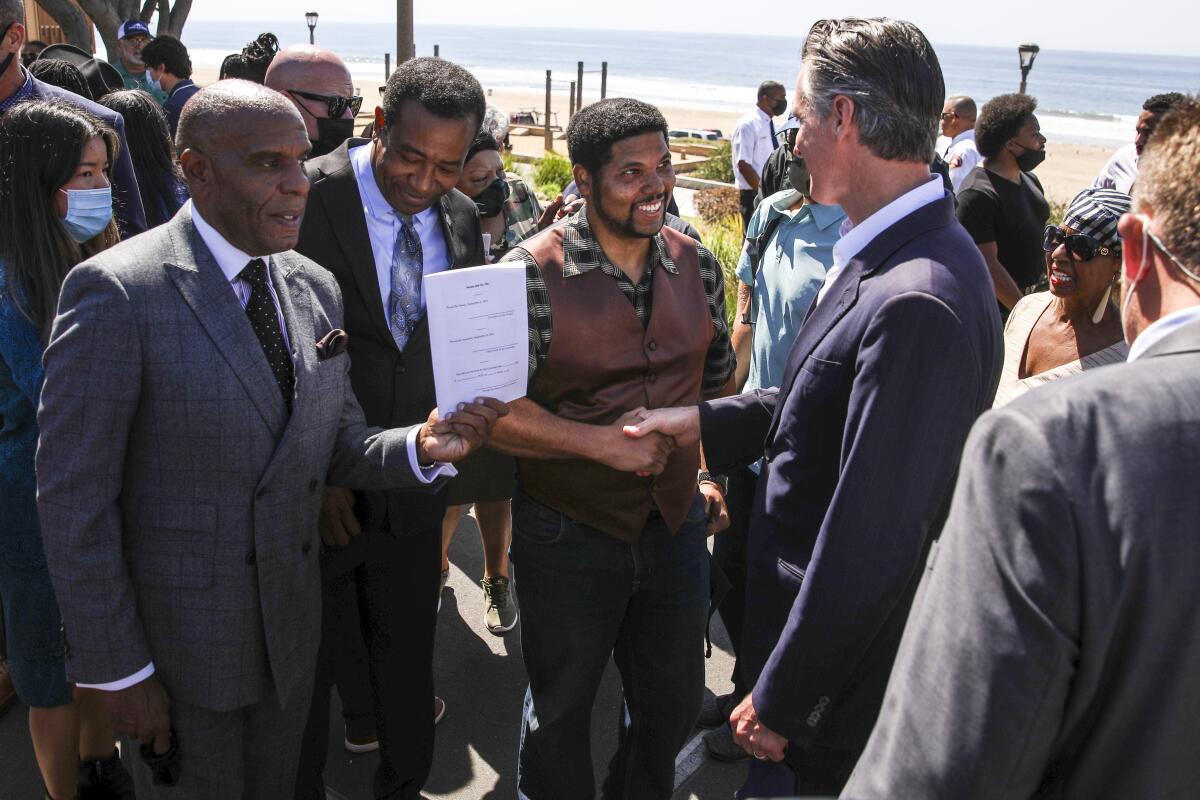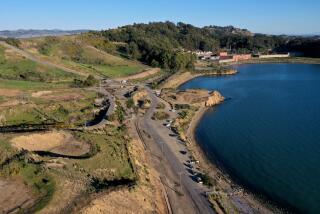Why Bruce’s Beach may be an outlier in terms of reparations for Black Americans

- Share via
Nearly 100 years after the property known as Bruce’s Beach was seized by Manhattan Beach through eminent domain, California has agreed to return the oceanfront parcels to the descendants of the Black couple who had owned it.
The move has been hailed as a watershed moment, touted by champions of reparations as a model for redress for land discriminatorily taken, and possibly a strategy for achieving what we call “true reparations.”
But true reparations would require eliminating the Black-white wealth gap. In California, that applies to about 2 million eligible Black residents. Estimates from the Federal Reserve’s 2019 Survey of Consumer Finances indicate that the difference in average Black and white household net worth was $840,900, which translates to about $350,000 per person.
If California were to use that figure as a reparations measure, it would require an expenditure of at least $700 billion — more than 2.5 times the state’s current $260-billion budget. Only states with a tiny Black population could afford to eliminate the gap.
Although the Bruce’s Beach case may be destined to be an outlier, it contains useful signposts. Rare among Black-owned property that was seized, the land is distinguished by a record of sustained advocacy by the Bruce family and their allies, as well as documentation that can make the case for restitution.
There is no comprehensive record of the seizure of Black-owned property during the nearly 100 massacres executed by white supremacists nationwide between 1870 and 1940. While the intent of the racist mobs was often publicized, deeds of record and property valuations for the homes and businesses of legions of Black families frequently were destroyed, and the injured and dead were never officially tallied.
When a white mob descended upon a Black neighborhood in 1921 in Tulsa, Okla., 300 people were murdered and 10,000 Black residents were left homeless. Sometimes properties taken were disguised as “voluntary sales” in public registers. This is what happened in 1920, in Ocoee, Fla., after a white mob, enraged by Black people attempting to vote, attacked them.
When city records do include information about previous owners, they rarely reflect candid expressions of racist intent that informed the selection of a Black community as the site for a park or a new highway, for instance. But a Manhattan Beach developer, Frank Daugherty, baldly discussed the racist motivations behind the condemnation of the Bruce’s land. In the Manhattan Beach News in 1943, he said, “Our attorneys advised the members of the council never to admit the real purpose in establishing the park, especially during the city council meeting.”
As of 1912, Willa Bruce had paid $1,225 for the first of two lots in Manhattan Beach. Her husband, Charles, worked as a railroad dining-car chef, while she operated the beach resort. When Black families were drawn to it, white neighbors threatened and harassed the guests, and vandalized the resort property.
When racism didn’t drive out the Black visitors, the city began condemnation proceedings in 1924. Eventually, more than two dozen properties, including the Bruces’, were seized. Downplaying the costs to the displaced families and citing the need for a greater social good, officials claimed there was an urgent need for a public park, but the land was allowed to lie fallow for decades. The two parcels were transferred to the state in 1948 and then to Los Angeles County in 1995.
The Bruce family had requested $120,000 in compensation — $70,000 for the two lots and $50,000 in damages — but received $14,500 from the city in 1929. The land is estimated to be worth $75 million today.
Even with a transparent paper trail of ownership, it will be challenging to return the full value of the Bruce’s Beach property and the properties of their Black neighbors. For one, legal descendants must be identified and verified. Then they should be compensated for the difference between what their ancestors were paid for the land taken by eminent domain and its current market value, and for the accumulated interest and lost income those properties might have generated over the last 100 years.
In January, Santa Monica announced its intention to make amends for elements of its racist past. Fifty years ago, at least 600 families in predominantly Black neighborhoods were forced out to make room for the 10 Freeway and the Santa Monica Civic Auditorium. Now, the city is offering affordable housing to those displaced families. Renters got nothing when they were kicked out, while homeowners lost the ability to earn intergenerational wealth. Families with documentation of their displacement will be eligible.
It’s too soon to know how many families will benefit and, of course, the proposed compensation is clearly not enough. Governments need a process to return thousands of plots of land stolen from Black families. None has ever been proposed, and it would be complicated to carry out.
But it can be done.
California could lead the way by launching a racial-equity initiative in the form of an agency tasked with helping Black families make their petitions, then adjudicating their claims at no cost to the applicants.
Folklorists and oral historians could interview families and help them access the details of how the actions of state and local governments caused them to suffer. Attorneys could identify the documents families would need to bolster their cases, and research librarians could search for them. Databases could be set up that would be publicly accessible and valuable in documenting other cases.
A racial-equity initiative is not the same as a reparations program, but it is a huge step that states could take. The Bruce’s Beach case shows that documentation and the public’s insistence on accountability may be key to governments moving forward as they try to rectify an egregious historical wrong.
A. Kirsten Mullen and William A. Darity Jr. are the authors of “From Here to Equality: Reparations for Black Americans in the Twenty-First Century.”
More to Read
A cure for the common opinion
Get thought-provoking perspectives with our weekly newsletter.
You may occasionally receive promotional content from the Los Angeles Times.









